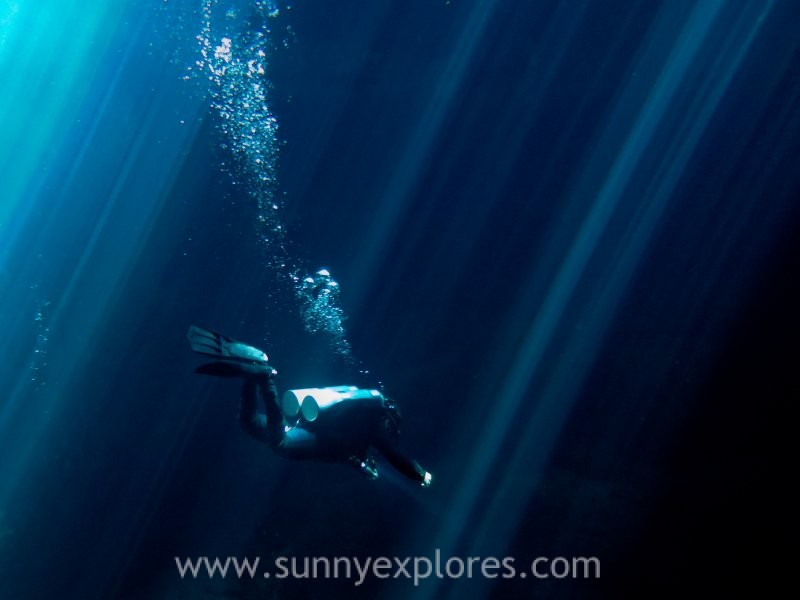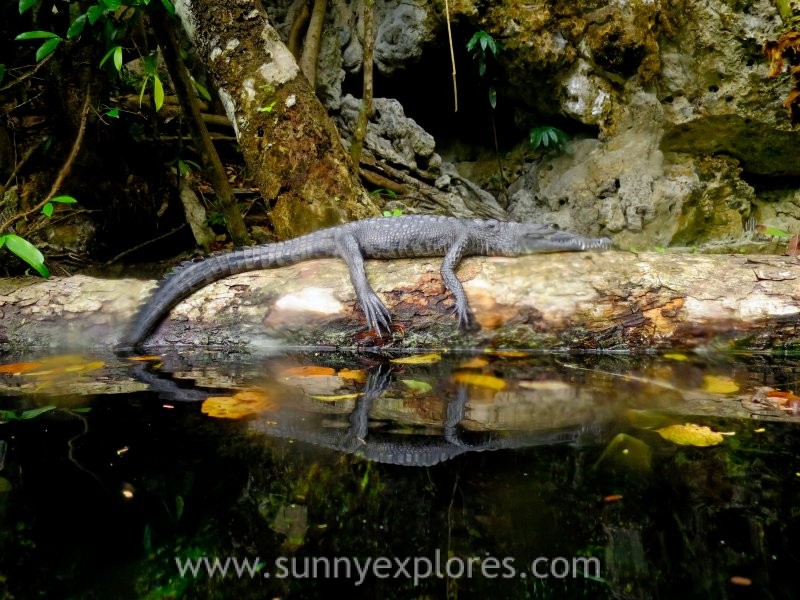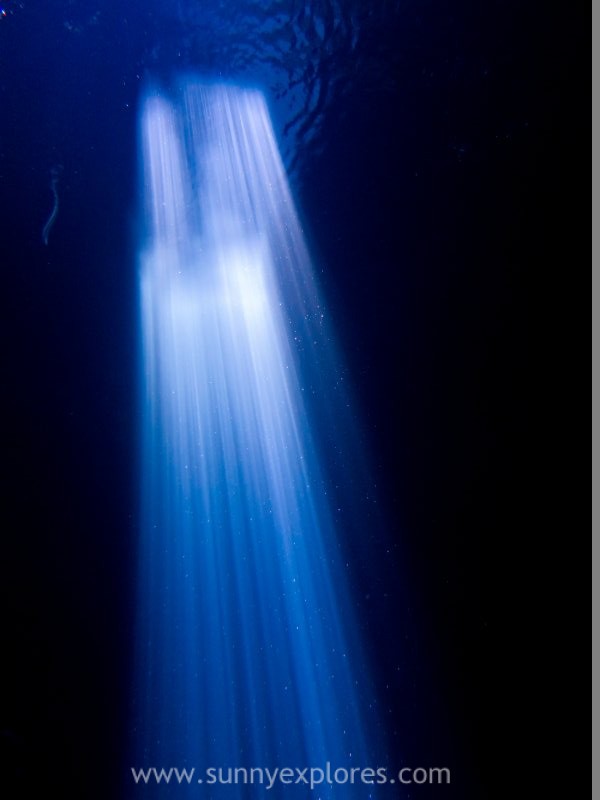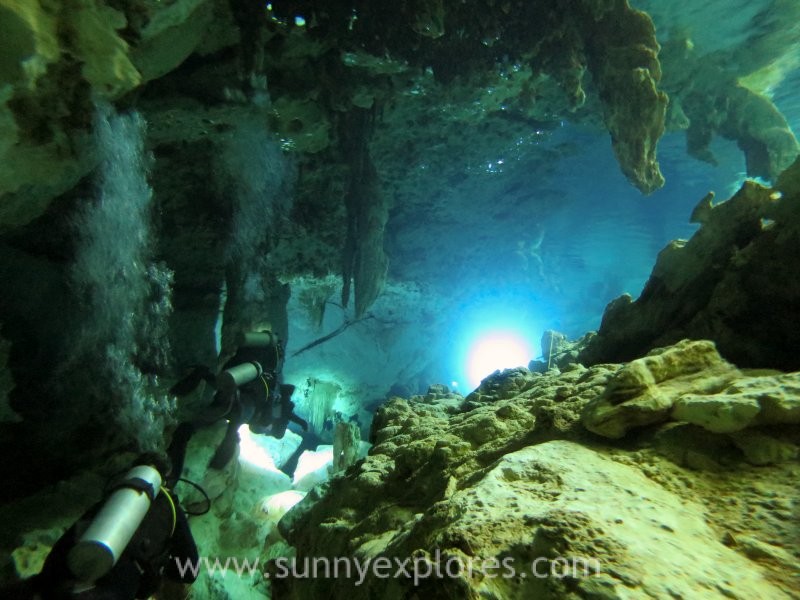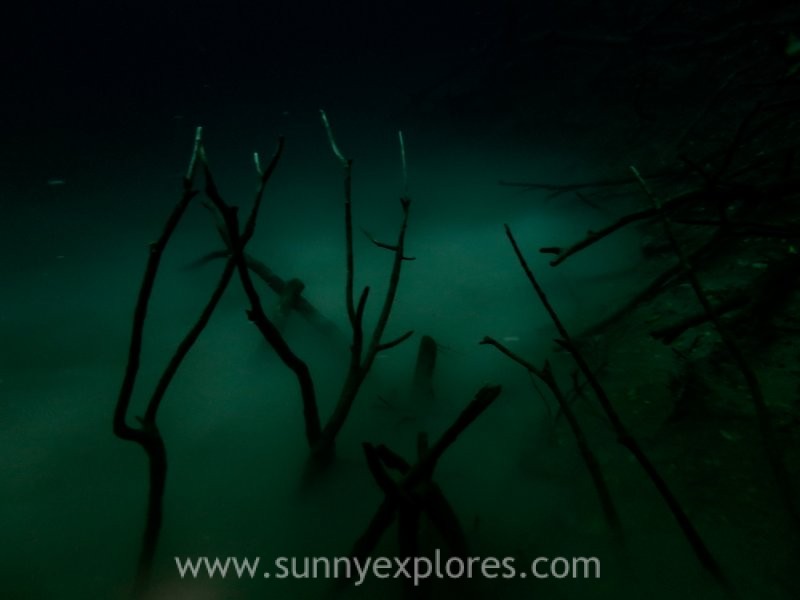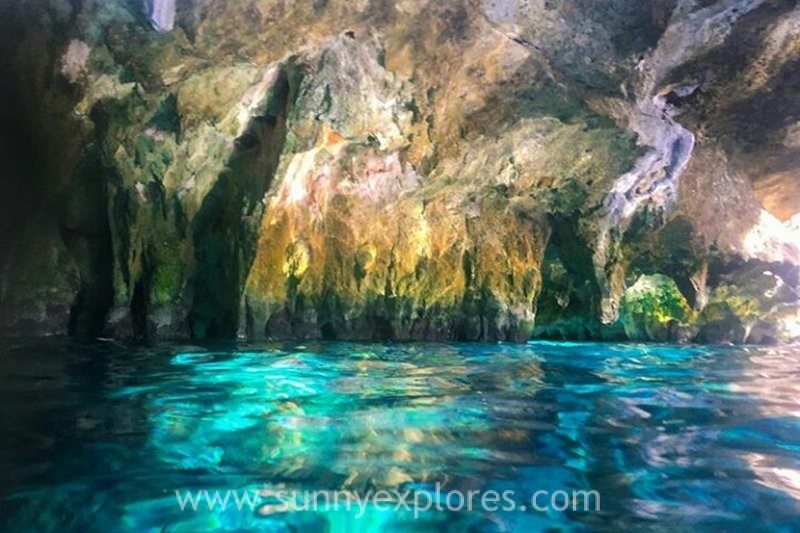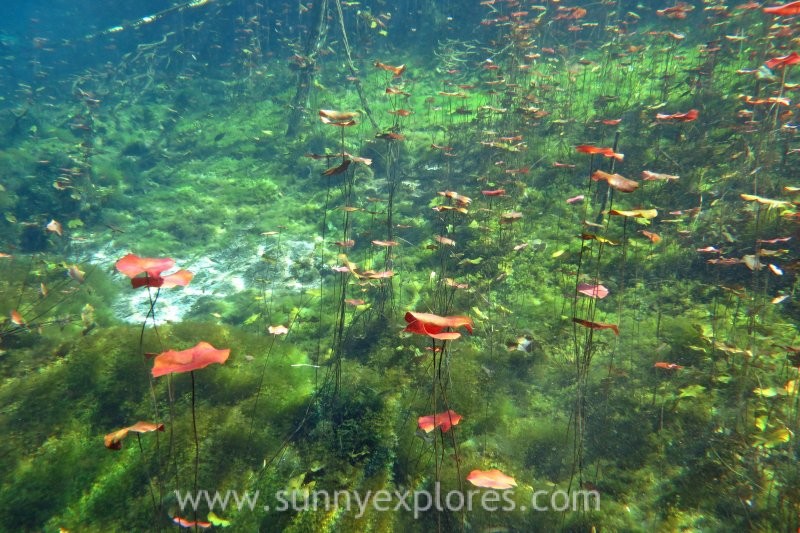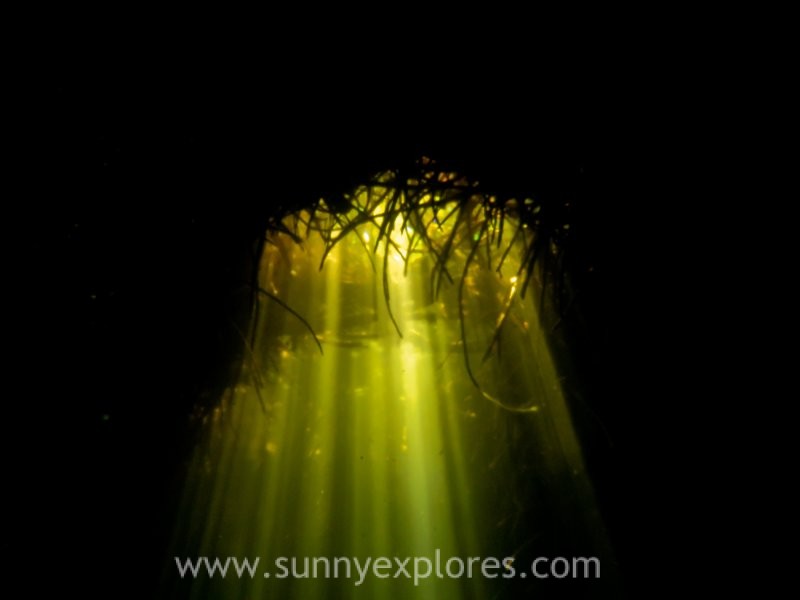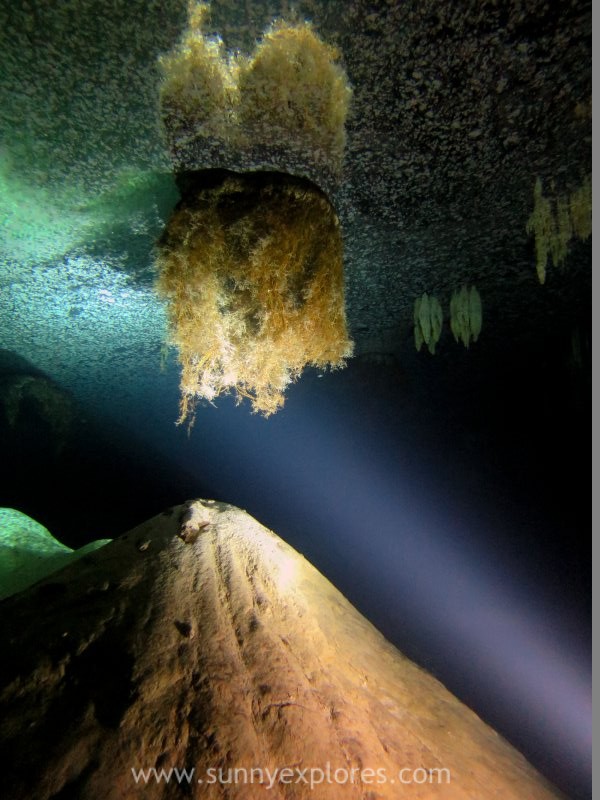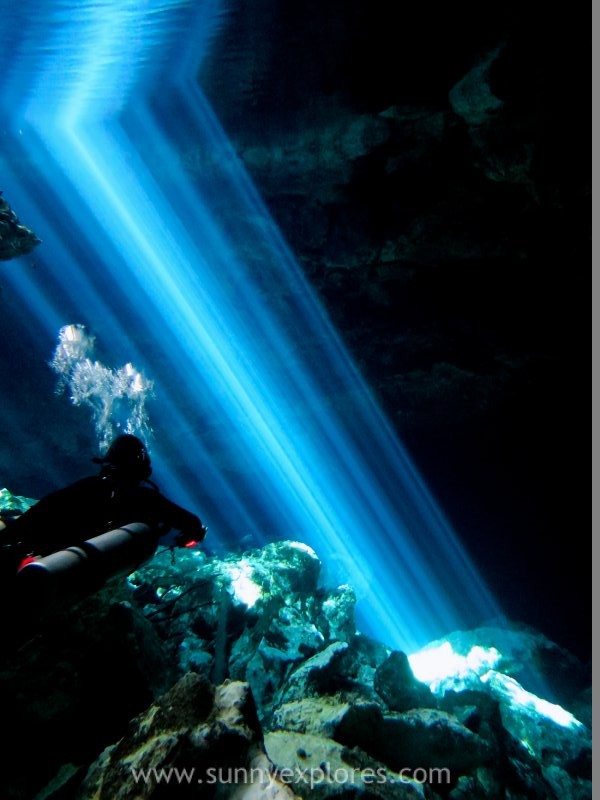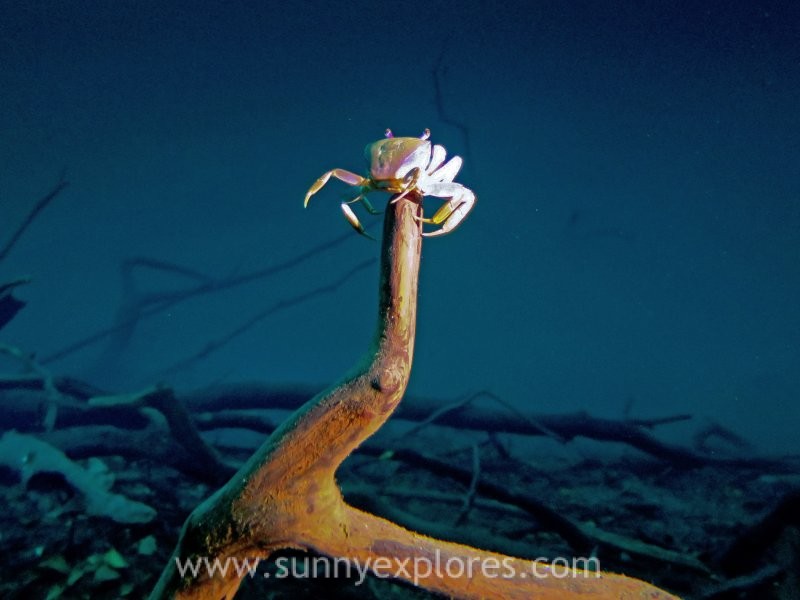Diving in Mexico: the Cenotes in Yucatán
November 7, 2019
Sunbeams make their way through the cave opening, the turquoise water shimmers in the light, and lianas entwine from the walls into the water. Cenotes are out of this world.
Some of them go so deep that even technical divers haven’t reached the end. Some are crystal clear caves filled with low hanging stalactites and stalagmites. Some have no plant life, others are abundantly filled with water lilies, algea and lianas. Some are the homes of turtles, crabs and fish. Some even house crocodiles. Others still contain Mayan altars or offerings. All cenotes are different, all are wonderful and pure magic. I can hardly finds the right words to describe Yucatán’s cenotes.
There are more than 300 cenotes in Yucatán. The word comes from the Mayan word tso’ono’ot, which means abyss or cave filled with water. Cenotes occur in areas where there are no aboveground rivers. The Yucatán peninsula consists of porous limestone, in which long ago holes were formed by rain water that seeped deep into the soil. In places where cavities were formed, the top layer of the limestone collapsed, revealing deep, natural, green-blue water sources, often surrounded by lush vegetation. The water seeps through the porous soil and flows to the sea via underground rivers. Geologically these natural springs in limestone are called karst pits.
For the Mayans, cenotes were sacred places, entrances to the underworld. They used the cenotes to make sacrifices to the Gods. Rain god Chaac also demanded human sacrifices and some cenotes contain still human remains. Around the cenotes ceremonial centers arose. Most of them are beautifully hidden in the jungle. For me the cenotes are as magical above the ground as under water. How often do you get the chance to enter the jungle with your diving equipment? You can’t visit Mexico without diving into the mysterious and alluring underground sinkholes. Here are my 8 favorite cenotes.
The jungle between Playa del Carmen and Tulum hides the Pit, one of the world’s most intriguing cavern dives. To reach the site, divers previously had to trek through the jungle and descend about 6 meters to enter the water. A recently constructed dirt road leading to the entrance and the addition of stairs to the water, have made the Pit much more accessible. It’s the deepest cenote in Quintana Roo with 119 meters of depth. The Pit offers a breathtaking visibility and stalactites of all sizes in the first 30 meters. At that depth there is a hydrogen sulfide cloud that divers can penetrate to descend into complete darkness at around 40 meters. And when you look close, you might even discover ancien human and animal remains. This cenote is spectacular and lights beams are amazing. Read more about diving in Cenote El Pit here!
Dos Ojos is perhaps the most famous cenote of all. Dos Ojos means ‘two eyes’ and consists of two connected cenotes, with a shared cavern zone. They are part of a larger cave system. There are 28 known sinkhole entrances in the Dos Ojos system and the exploration of the system continues till today. Divers walk a short distance through the jungle to the entrance. The ‘Barbie Line’ dive takes place along the opening of the ‘Second Eye’. Here is lots of daylight and immaculate visibility. The second dive, also known as the Bat Cave, requires divers to follow a line that twists and turns through tight swim-throughs, where light begins to disappear into the distance behind them. You will end up into a stalactite-filled chamber with hunderds of bats. Read more about diving in Cenote Dos Ojos here.
Cenote Angelita is a grazy dive. A short walk into the jungle reveals a cenote that descends directly to 60 meters, with no side passages or offshoots. Angelita means ‘little angel’ and holds a mix of salt and fresh water. At around 30 meters, there is a hydrogen sulfide cloud that sits atop the cenote’s saltwater layer. Here, in this misty cloud in the depths of the cenote, divers will see trees and branches. They peek out of the cloud, creating a surreal scene. The hydrogen sulfide ‘fogs’ the water and when you look up and see the sunlight filtering down throught ancient submerged tree branches, making them look like witches with arms widespread. Diving this cenote is surreal! Read more about diving in Cenote Angelita here.
Who doesn’t want to dive in a cenote, also known as the Temple Of Doom? The Temple Of Doom cenote looks as cool as it sounds with multiple openings that peek down into the mesmerizing starling blue waters underground. The most daring way to get into the cenote is by jumping, in full diving gear, through one of the smaller openings in the ground. Who dares to jump in the Temple of Doom? Your reward is a magical journey in a world full of stalactites and stalagmites. Read more about diving in Cenote Calavera here.
Cenote Carwash is actually called Cenote Aktun Ha, meaning ‘Water Cave’ in Mayan. This Cenote used to be the spot where the Tulum taxi drivers washed their taxis in the 80’s. Aktun Ha is an excellent example of the natural collapse formation of sinkholes. It looks like a giant pond. The entrance of the cavern is very wide with a lot of light penetration. A screen of dead trees in front of it creating the enchanting effect of a drowned forest. Looking back out of the entrance from the cavern through the silhouette of the trees at the green or red light streaming through the opening is a stunning sight. Read more about diving in Cenote Carwash here.
Casa Cenote, also called Cenote Tankah, connects one of world’s longest underwater cave systems, Nohoch Na Chich, with the ocean. In the middle of a lush mangrove forest, diving in Casa Cenote offers the unique feeling of diving under a tropical rainforest. The dive never exceeds 8 meters and follows the course of the surface river, with big open areas. Because of the river’s connection to the ocean, Casa Cenote features a fresh- and saltwater mix so you can see both fresh- and saltwater fish. I loved the magroves and I can understand once this was a manatee area. And yes, I was so lucky to meet the resident crocodile! Read more about diving in Casa Cenote here.
Cenote Dreamgate is a cavern dive for experienced divers with good buoyancy control. It’s dark: the only light here comes from your torch. Dreamgate Cenote is a series of shallow horizontal caverns that form a circuit. You can combine two magnificent dives here, Dreamgate Upstream and Dreamgate Downstream. During this dive soda straw formations can be seen. These are the preliminary stage in the growth of stalactites. The most magical are the reflections of the stalactites from the ceiling into the water. It creates an enchanting mirror world and it feels you are flying between the stalactites and columns. Read more about Cenote Dreamgate here!
The Tajma Ha is an amazing dive. It has sections of rocks that glow when you shine your torch on them. Shards of light enter the caves from above and are refracted by the water’s surface to create surreal effects. As you begin your dive, you will pass under a huge air filled cave, home to a few bats. Their entry and exit points are like windows providing stunning rays of sunlight. It’s an amazing light show. The rock formations, haloclines, light effects and fossils make this cenote an exceptional dive, very different from all the others. Read more about Cenote Tajma Ha here!
As I wrote: all cenotes are wonderful dives and all are pure magic. I can’t name my favorite dive here. Did you ever dive in the cenotes? I would love to know what your favorite cenote is! I have done all my dives in Mexico, the cenotes as well as Tulum reef dives and dives in Cozumel with divecenter Infinity2diving. I can warmly recommand them!
